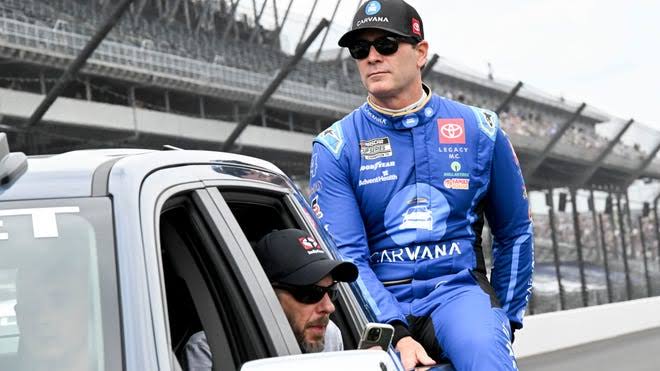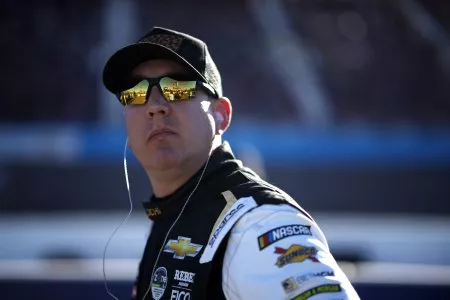“I Don’t Care How Long He’s Been Doing It” – When Chase Elliott Expressed Disappointment in Kevin Harvick’s Driving Style
The NASCAR Cup Series is filled with intense rivalries, competitive drives, and high-stakes moments, but few instances are as striking as when a young driver voices their displeasure about a veteran’s behavior on the track. In 2020, Chase Elliott, the 2020 NASCAR Cup Series champion and fan-favorite driver for Hendrick Motorsports, expressed his frustration with Kevin Harvick, a seasoned veteran with over two decades of experience in the series. Elliott’s comment, “I don’t care how long he’s been doing it,” stirred considerable conversation in the NASCAR community and left fans and analysts alike wondering about the deeper layers of respect, frustration, and competitiveness that exist in NASCAR racing.
The comment came after an altercation during a race, with Elliott directly criticizing Harvick’s aggressive driving style. At its core, this exchange was about the clash of personalities and racing philosophies between two drivers at different points in their careers—Elliott, still seen as a young up-and-comer, and Harvick, a driver who had been in the sport long enough to earn both admiration and disdain for his take-no-prisoners approach on the track.
To fully understand the weight of Chase Elliott’s words, it is important to explore the history behind this rivalry, the significance of driving styles in NASCAR, and the pressures faced by both drivers within the broader context of their careers.
The Build-Up to the Disagreement
The root of the friction between Elliott and Harvick dates back to a specific incident during the 2020 NASCAR Cup Series season. At the NASCAR All-Star Race, held at Bristol Motor Speedway in July of that year, the two drivers found themselves at odds. A controversial move by Harvick, which involved aggressive blocking and bumping, resulted in Elliott feeling that his rival was using overly aggressive tactics. In an interview following the race, Elliott expressed his displeasure, claiming that Harvick’s actions were disrespectful and unnecessary. It was clear that, in Elliott’s eyes, Harvick’s experience did not excuse what he saw as a reckless approach to racing.
While such clashes are not uncommon in NASCAR, Elliott’s comment, “I don’t care how long he’s been doing it,” spoke volumes about his outlook on racing and the competitive environment in which both drivers operated. For Elliott, it wasn’t a matter of Harvick’s experience or how long he had been successful in the sport—it was about the standards of respect, fairness, and sportsmanship that he believed should apply to all drivers, regardless of tenure.
This incident was not isolated. Over the course of their careers, Harvick and Elliott had developed a subtle yet noticeable rivalry. On one hand, Harvick, a former champion, was known for his no-nonsense, aggressive driving style, while Elliott, the son of NASCAR Hall of Famer Bill Elliott, had earned a reputation as a more measured and calculating driver. Their contrasting approaches inevitably led to moments of tension.
In the eyes of many fans, Harvick was a grizzled veteran who had earned his place in the NASCAR hierarchy through years of hard-fought battles on the track. Elliott, on the other hand, represented the future of the sport—a young, talented driver with the potential to carry NASCAR’s legacy forward. That dynamic made their interactions all the more intriguing to those following the sport.
Chase Elliott’s Philosophy of Racing
Chase Elliott’s comment about Harvick’s driving style is revealing of the way Elliott views the art of racing. As a driver with a well-known family pedigree and a strong fan base, Elliott’s rise to prominence in NASCAR was always accompanied by a sense of expectation. Yet, despite the pressure, Elliott remained grounded in his belief that racing should be about precision, respect, and clean competition.
Unlike some of his contemporaries, Elliott’s driving style has been defined by consistency, skill, and a level-headed approach to competition. Throughout his career, he has been known for his ability to race cleanly, avoid unnecessary contact, and maintain a strategic approach to long races. This philosophy of racing was developed in part through the guidance of his father, Bill Elliott, a former Cup Series champion who was known for his smooth and patient driving style. Bill’s influence has clearly had an impact on Chase’s career, shaping the way he approaches each race and how he interacts with his competitors.
However, NASCAR is a sport built on aggression, strategy, and competition. To succeed at the highest level, drivers often need to strike a delicate balance between playing it safe and making bold moves. For Elliott, his criticisms of Harvick’s approach were not necessarily rooted in a desire for conflict but rather an attempt to push back against a style he felt was unnecessarily confrontational. For Elliott, racing hard didn’t mean racing dirty.
One of the defining moments of Elliott’s career came when he clinched the 2020 NASCAR Cup Series championship. In a season marred by uncertainty due to the COVID-19 pandemic, Elliott emerged as a steady and calculated driver who could withstand the pressure of high-stakes racing. His ability to race cleanly and consistently made him a fan favorite, particularly among younger fans who admired his calm demeanor and his refusal to get caught up in unnecessary drama.
In Elliott’s mind, racing was more than just about winning—it was about the process, the respect for fellow competitors, and a commitment to fair play. When he expressed disappointment in Harvick’s aggressive tactics, he wasn’t just reacting to a single instance on the track; he was reflecting his broader approach to racing as a whole.
Kevin Harvick: The Aggressive Veteran
In stark contrast to Elliott, Kevin Harvick is known for his aggressive, sometimes volatile, driving style. Harvick’s career has been defined by his relentless pursuit of success, often pushing the limits of what is considered acceptable driving in the NASCAR world. Harvick has had a remarkable career, winning multiple Cup Series races and a championship in 2014. Over the years, he has become synonymous with hard racing, a no-holds-barred mentality, and a reputation for not backing down from a fight.
Part of what made Harvick such a successful driver was his ability to adapt to the ever-changing dynamics of NASCAR. Whether it was the transition from the late Dale Earnhardt’s car to his own No. 29 car or the shift in focus from one type of racing strategy to another, Harvick proved that he could survive—and thrive—in the sport’s most challenging environments. But with that adaptability came a willingness to get his hands dirty, both figuratively and literally. Harvick’s aggressive tactics were often seen as a necessity for survival in NASCAR, a reflection of the brutal competition that characterized the sport.
Harvick’s willingness to use his bumper to move opponents out of the way, his ability to hold his ground in tense on-track moments, and his refusal to let rivalries fade into the background all helped cement his reputation as a driver who would never back down. For Harvick, racing wasn’t just about being fast; it was about establishing dominance, making your presence felt, and always asserting your will on the track.
In contrast to Elliott’s measured approach, Harvick’s style was often seen as abrasive—at least by those who didn’t admire his aggression. As a result, Harvick became one of the sport’s most polarizing figures. Fans either loved him for his willingness to take risks or disliked him for what they saw as an overzealous approach to racing.
For Harvick, a driver who had been in the sport for over two decades, experience and the ability to assert control on the track were invaluable. He knew how to push the limits of NASCAR’s often unwritten rules and had the backing of years of success to justify his approach. Harvick’s legacy as one of NASCAR’s fiercest competitors was built on his ability to drive with an edge—something that came naturally to him and that, he would argue, was necessary for maintaining a competitive edge in the modern era of racing.
The Clash of Philosophies
When Chase Elliott voiced his displeasure with Kevin Harvick’s driving style, it underscored a fundamental difference in the way each driver approached the sport. For Elliott, respect for fellow competitors was paramount. He believed that driving hard should not come at the expense of the other driver’s safety or integrity. Elliott’s philosophy of racing was rooted in the idea that a driver’s skill should shine through in their ability to pass, defend, and strategize without resorting to dirty tactics or reckless moves.
In contrast, Harvick viewed racing as a battle for position, where survival of the fittest was part of the game. In his mind, NASCAR’s high-speed, high-stakes environment demanded bold moves, even if they occasionally ruffled feathers. Harvick’s willingness to mix it up on the track often left him at odds with drivers who preferred a cleaner, more strategic approach. His long career in NASCAR had taught him that sometimes, the best way to win was to be unrelenting, even if it meant stepping on a few toes along the way.
For Chase Elliott, the incident with Harvick was a reminder of the generational divide within NASCAR. Younger drivers like Elliott, who grew up in a different era of racing, were less inclined to tolerate the “old-school” aggressive tactics that had defined much of Harvick’s career. As the sport evolved, new drivers brought with them a sense of respect and a desire for fairness—qualities that, in their view, should be part of the racing ethos.
Conclusion: A Moment of Growing Pains
Chase Elliott’s comment about Kevin Harvick—“I don’t care how long he’s been doing it”—was a powerful statement of defiance, but it also revealed the





